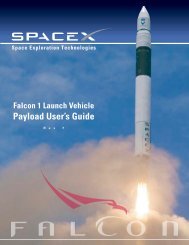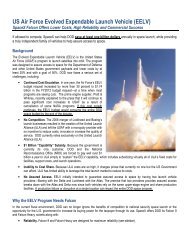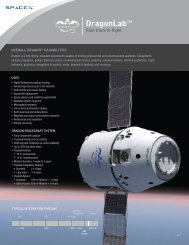Falcon 9 Launch Vehicle Payload User's Guide - SpaceX
Falcon 9 Launch Vehicle Payload User's Guide - SpaceX
Falcon 9 Launch Vehicle Payload User's Guide - SpaceX
Create successful ePaper yourself
Turn your PDF publications into a flip-book with our unique Google optimized e-Paper software.
2. <strong>Vehicle</strong> Overview<br />
<strong>Falcon</strong> 9 User’s <strong>Guide</strong><br />
2.1. <strong>Falcon</strong> 9 <strong>Launch</strong> <strong>Vehicle</strong>s<br />
<strong>Falcon</strong> 9 <strong>Launch</strong> <strong>Vehicle</strong>s are designed to provide breakthrough advances in reliability, cost, and<br />
time to launch. The primary design driver is, and will remain, reliability. <strong>SpaceX</strong> recognizes that<br />
nothing is more important than getting a customer’s payload safely to its intended destination.<br />
The initial flights of the <strong>Falcon</strong> 9, currently planned in 2009 and 2010, use the <strong>Falcon</strong> 9 Block 1.<br />
Beginning in late 2010/early 2011, <strong>SpaceX</strong> will begin launching the <strong>Falcon</strong> 9 Block 2. Block 2<br />
features increased engine thrust, decreased launch vehicle dry mass, and increased propellant<br />
load ‐ combined with lessons learned from the flights of the <strong>Falcon</strong> 9 Block 1. This results in<br />
increased mass‐to‐orbit performance for the <strong>Falcon</strong> 9 Block 2 when compared with Block 1<br />
performance. This performance is shown in the <strong>Falcon</strong> 9 performance tables presented later in<br />
this document.<br />
2.1.1. Structure and Propulsion<br />
Like <strong>Falcon</strong> 1, <strong>Falcon</strong> 9 is a two‐stage, liquid oxygen (LOX) and rocket grade kerosene (RP‐1)<br />
powered launch vehicle. It uses the same Merlin engines, structural architecture (with a wider<br />
diameter), and launch control system.<br />
The <strong>Falcon</strong> 9 propellant tank walls and domes are made from an aluminum lithium alloy.<br />
<strong>SpaceX</strong> uses an all friction stir welded tank, the highest strength and most reliable welding<br />
technique available. Like <strong>Falcon</strong> 1, the <strong>Falcon</strong> 9 interstage, which connects the upper and lower<br />
stages, is a carbon fiber aluminum core composite structure. The separation system is a larger<br />
version of the pneumatic pushers used on <strong>Falcon</strong> 1.<br />
Nine <strong>SpaceX</strong> Merlin engines power the <strong>Falcon</strong> 9 first stage with 125,000 lbf sea level thrust per<br />
engine, for a total thrust on liftoff of just over 1.1 million lbf. After engine start, <strong>Falcon</strong> 9 is held<br />
down until all vehicle systems are verified as functioning normally before release for liftoff.<br />
The second stage tank of <strong>Falcon</strong> 9 is simply a shorter version of the first stage tank and uses<br />
most of the same tooling, material and manufacturing techniques. This results in significant cost<br />
savings in vehicle production.<br />
A single Merlin engine powers the <strong>Falcon</strong> 9 upper stage with an expansion ratio of 117:1 and a<br />
nominal burn time of 345 seconds. For added reliability of restart, the engine has dual<br />
redundant pyrophoric igniters (TEA‐TEB).<br />
The <strong>Falcon</strong> 9 fairing is 17 ft (5.2 m) in diameter.<br />
2.1.2. Avionics, Guidance/Navigation/Control, Flight Termination Systems<br />
<strong>Falcon</strong> 9 vehicle avionics features a single‐fault tolerant architecture and has been designed<br />
with a view towards human‐rating requirements in order to allow future qualification for<br />
SCM 2008‐010 Rev. 1 Copyright ‐‐ <strong>SpaceX</strong> 2009 8





